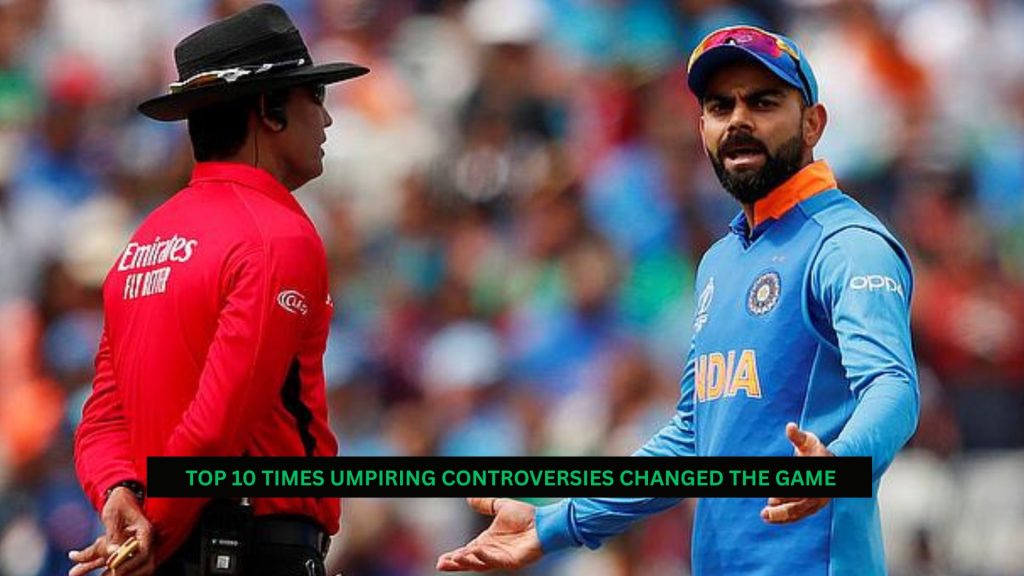Table of Contents
In cricket, a single decision can flip the match on its head. While umpires strive for fairness, even the best make errors—some so critical that they rewrite cricket history. These umpiring controversies triggered global debates, heartbreaks, and even changes in the laws of the game.
Here are the Top 5 Umpiring Controversies that didn’t just cause drama—they changed the game.
1. England vs New Zealand – 2019 World Cup Final (Overthrow Rule)
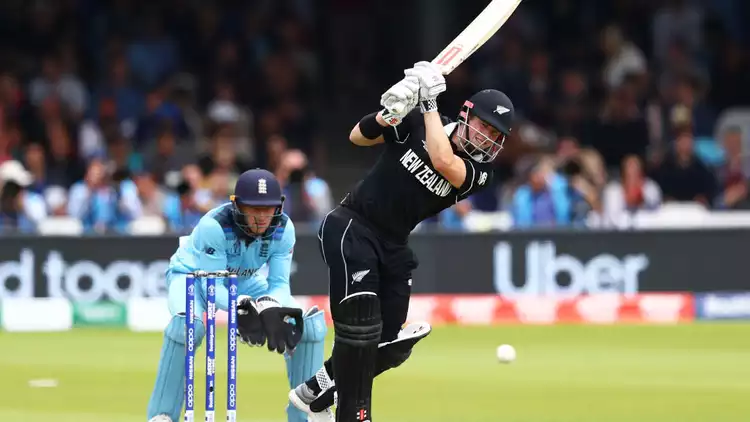
- Date: July 14, 2019
- Venue: Lord’s, London
- Controversy: 6 overthrow runs awarded instead of 5
In the final over, a throw from the deep deflected off Ben Stokes’ bat and ran away to the boundary. The umpire awarded 6 runs (2 runs + 4 overthrows). But the law stated that the batsmen must have crossed before the throw—they hadn’t.
Why It Changed the Game:
England went from needing 3 off 2 to just 3 off 1. That single umpiring decision arguably won them the World Cup.
Aftermath: The MCC later admitted the Umpiring Controversies was incorrect.
2. Australia vs India – 2008 Sydney Test (Monkeygate + Umpire Errors)
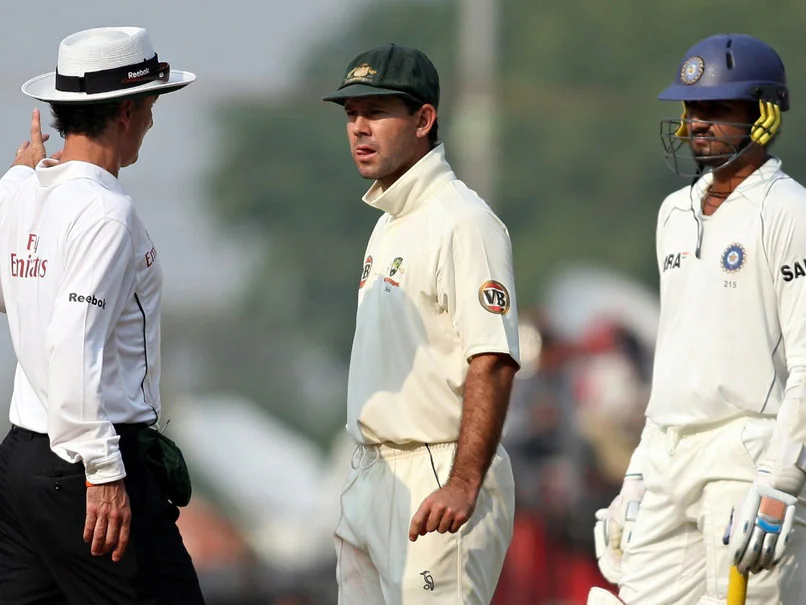
- Date: January 2–6, 2008
- Venue: SCG, Sydney
- Controversy: Multiple wrong decisions against India
Umpires Steve Bucknor and Mark Benson made several incorrect decisions, especially against India, such as wrongly giving Dravid caught behind when the ball hit his pad.
Why It Changed the Game:
India lost the match, sparking outrage. The test is forever known as the Monkeygate Test, with tensions at an all-time high.
Aftermath: Bucknor was dropped from the next Test. Sparked calls for DRS expansion.
3. South Africa vs England – 1992 World Cup Semi-Final (Rain Rule Farce)
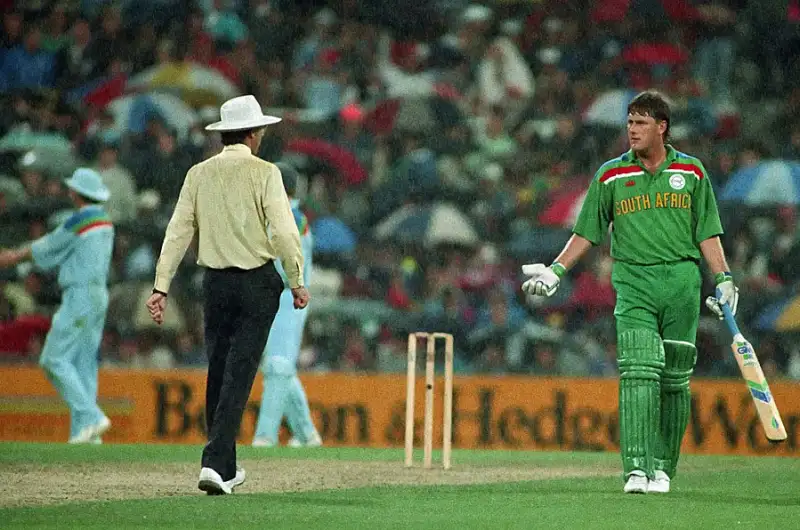
- Date: March 22, 1992
- Venue: SCG, Sydney
- Controversy: Revised target from 22 off 13 to 22 off 1 due to rain
A sudden rain break led to a mathematical blunder using the old rain rule. South Africa needed 22 off 13 balls—but after a 12-minute break, they suddenly needed 22 off 1.
Why It Changed the Game:
South Africa was robbed of a fair chase. The backlash forced the ICC to introduce the Duckworth-Lewis method later.
Aftermath: It ended South Africa’s World Cup dreams and changed rain rules forever in Umpiring Controversies.
4. Sri Lanka vs Australia – 1996 World Cup Semi-Final (Mankading Confusion)
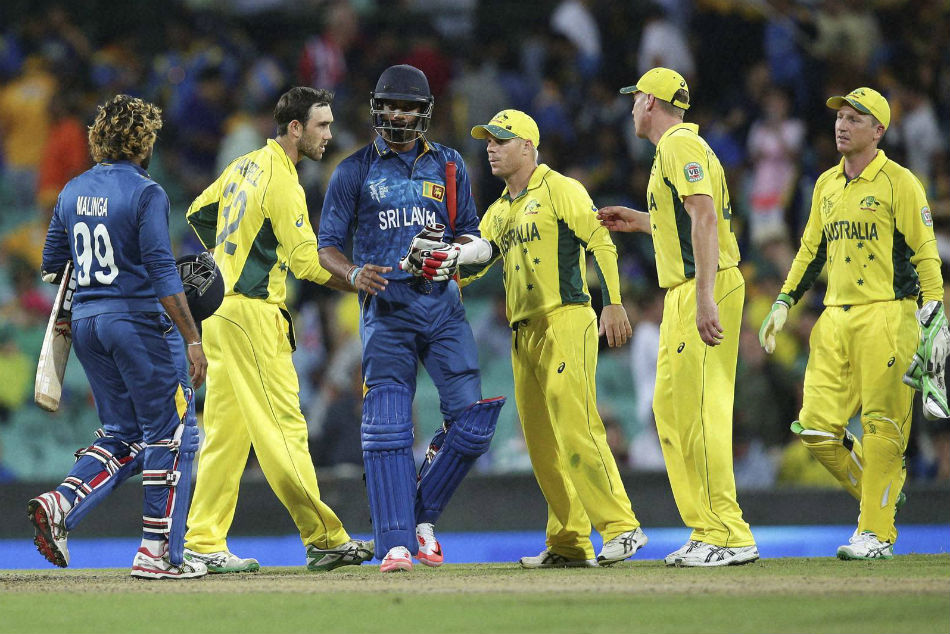
- Date: March 13, 1996
- Venue: Eden Gardens, Kolkata
- Controversy: Umpire confusion over Mankading warning
While not as high-profile as others, the confusion over Mankading rules saw an Australian bowler warn Sanath Jayasuriya multiple times without clarity, creating heated exchanges and inconsistent officiating.
Why It Mattered:
The lack of clarity led to later law revisions regarding Mankading, now officially termed “run out”.
Aftermath: Sparked conversations about the spirit of the game vs the rulebook.
5. West Indies vs India – 1974 Port of Spain Test (No-Ball Drama)
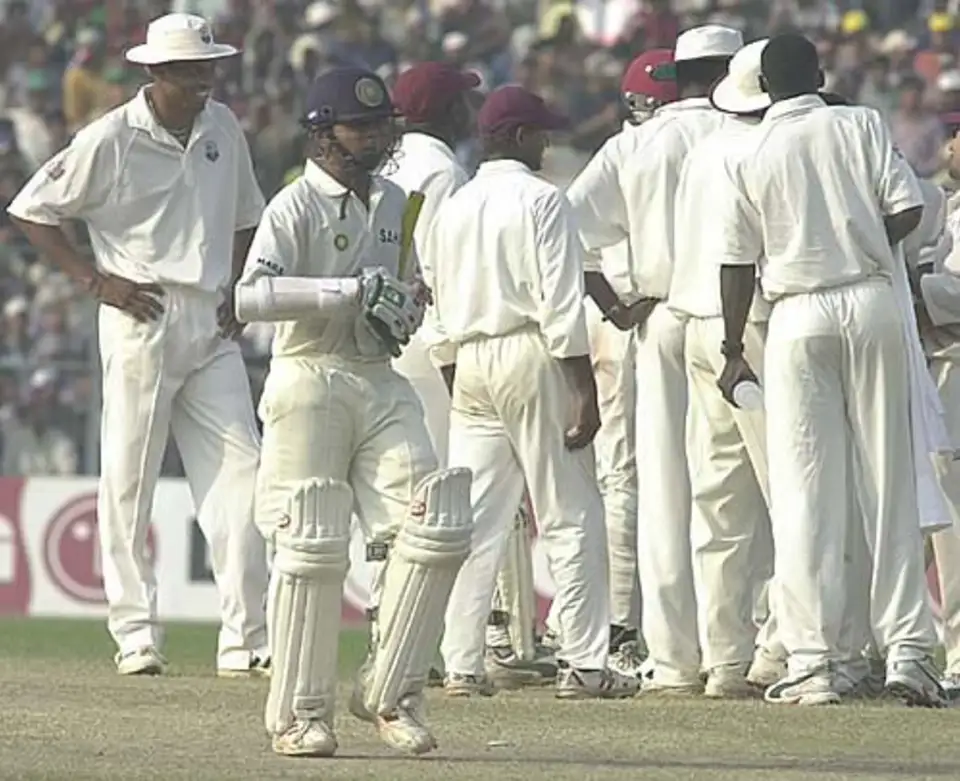
- Date: March 21–26, 1974
- Venue: Port of Spain
- Controversy: Michael Holding bowls no-balls that aren’t called
Indian batsmen repeatedly complained about overstepping by West Indian pacers. Umpires ignored several clear no-balls, allowing West Indies to dominate unfairly in Umpiring Controversies.
Why It Changed Things:
Led to renewed scrutiny of umpiring in the West Indies and later formalised front-foot no-ball rules.
Aftermath: Helped shape the push for neutral umpires in the 1990s.
6. India vs South Africa – 2015 World Cup (Rohit Sharma’s Wrong Dismissal)
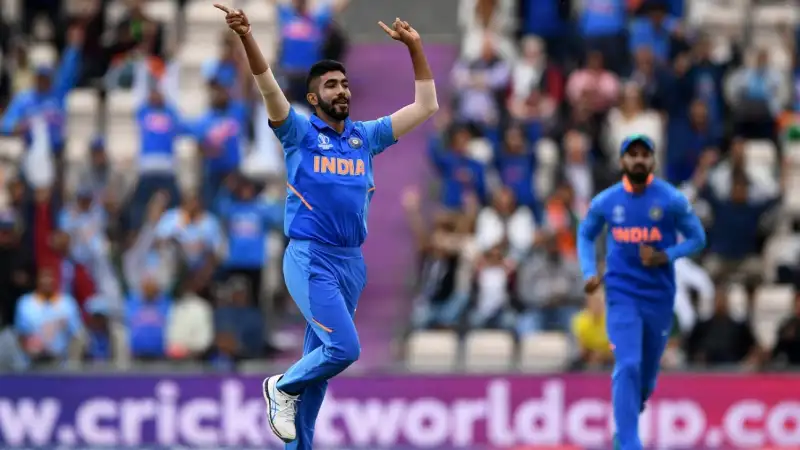
- Date: March 22, 2015
- Venue: MCG, Australia
- Controversy: Rohit Sharma was given out even though the ball was a clear no-ball
Rohit was clean-bowled by a full toss that was clearly above waist height, but the umpire did not signal a no-ball. India lost an in-form batter early.
Why It Sparked Outrage:
It happened on the biggest stage, with DRS not applicable for waist-high no-balls at that time.
Aftermath: ICC began reviewing umpire power over high full-tosses with more scrutiny, Umpiring Controversies.
7. Pakistan vs Australia – 2022 T20 World Cup Semi-Final
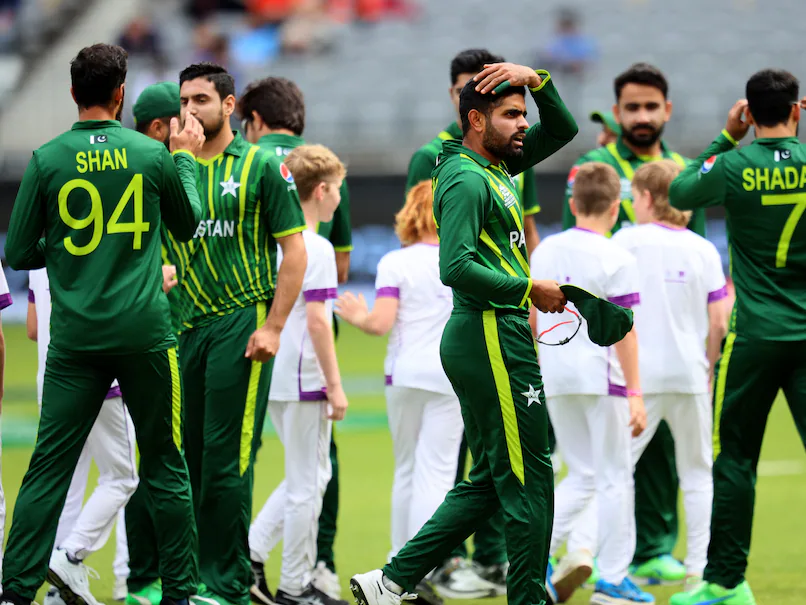
- Date: November 9, 2022
- Venue: SCG
- Controversy: Mohammad Nawaz’s final over not reviewed for a waist-high no-ball
Pakistan fans were furious as Stoinis survived a potential waist-high full toss on the final ball of Nawaz’s over. It was not checked by the third umpire.
Why It Hurt:
That ball effectively knocked Pakistan out in the Umpiring Controversies.
Aftermath: ICC faced calls to review final-over decisions more strictly.
8. Bangladesh vs India – 2018 Nidahas Trophy Final (No-Ball Confusion)
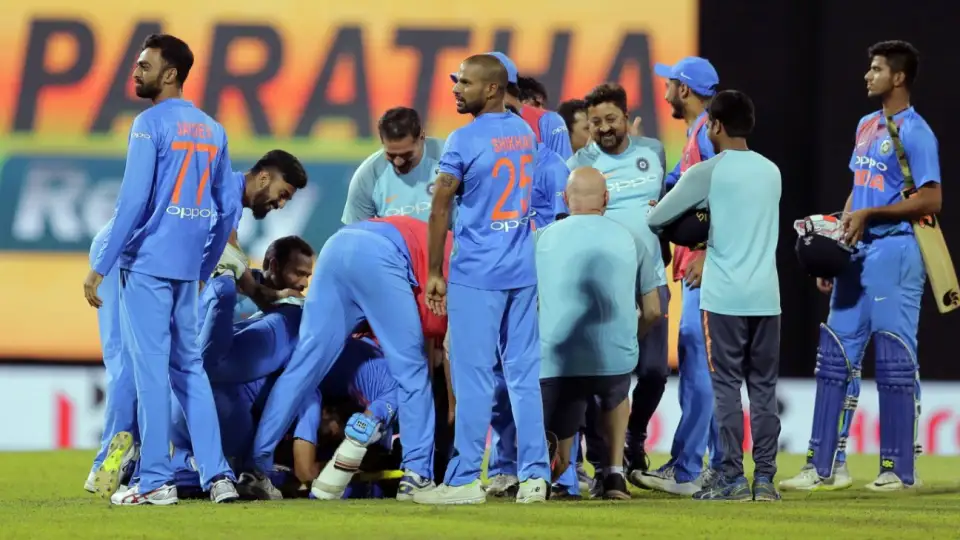
- Date: March 18, 2018
- Venue: Colombo
- Controversy: Umpires missed a clear no-ball during the tense final overs
India needed 5 off 1. Before Dinesh Karthik’s winning six, one delivery wasn’t called a no-ball despite being above waist height.
Why It Was Huge:
If it had been called correctly, India could’ve tied or won with less pressure.
Aftermath: Sparked debates about third umpire involvement in waist-high decisions
9. Sri Lanka vs England – 2014 ODI Series (Fake Appeal Incident)

- Date: December 2014
- Venue: Colombo
- Controversy: Sri Lankan fielder made a fake appeal and tricked the umpire into giving out Jos Buttler
The appeal was later proven to be based on deceptive body language, not genuine contact. Buttler was given out caught behind despite no edge.
Why It Was Controversial:
The “fake appeal” exposed how easily an umpire could be misled.
Aftermath: ICC re-emphasised the spirit of the game and sportsmanship.
10. India vs Australia – 2019 ODI (Third Umpire Delay)
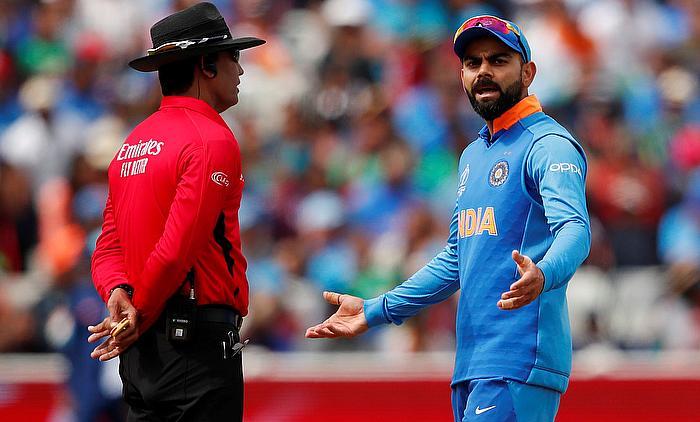
- Date: January 15, 2019
- Venue: Adelaide
- Controversy: DRS was delayed, and India lost a review opportunity in the Umpiring Controversies.
Kohli wanted to review a caught-behind appeal, but the umpire didn’t hear his request in time. India were denied a DRS they were entitled to.
Why It Was Infuriating:
In a close match, such a miscommunication was costly.
Aftermath: ICC updated protocols on DRS signal timing and communication in Umpiring Controversies.
Final Thoughts!
From misjudged no-balls to missed reviews and boundary-count decisions, these umpiring controversies show how thin the line between victory and heartbreak can be. Each of these moments didn’t just change the outcome of matches—they reshaped rules, stirred emotions, and exposed flaws in the system. Cricket may be a gentleman’s game, but it’s not immune to human error.
FAQ – Umpiring Controversies !
Q1. What was the most controversial umpiring decision in World Cup history?
The 2019 World Cup Final overthrow rule that gave England an extra run is widely considered the most debated.
Q2. Has umpiring ever led to rule changes?
Yes. The 1992 World Cup’s rain-rule fiasco led to the birth of the Duckworth-Lewis method.
Q3. What is the role of the third umpire in such controversies?
The third umpire can only intervene in limited cases (e.g., run-outs, boundaries) unless DRS is used.
